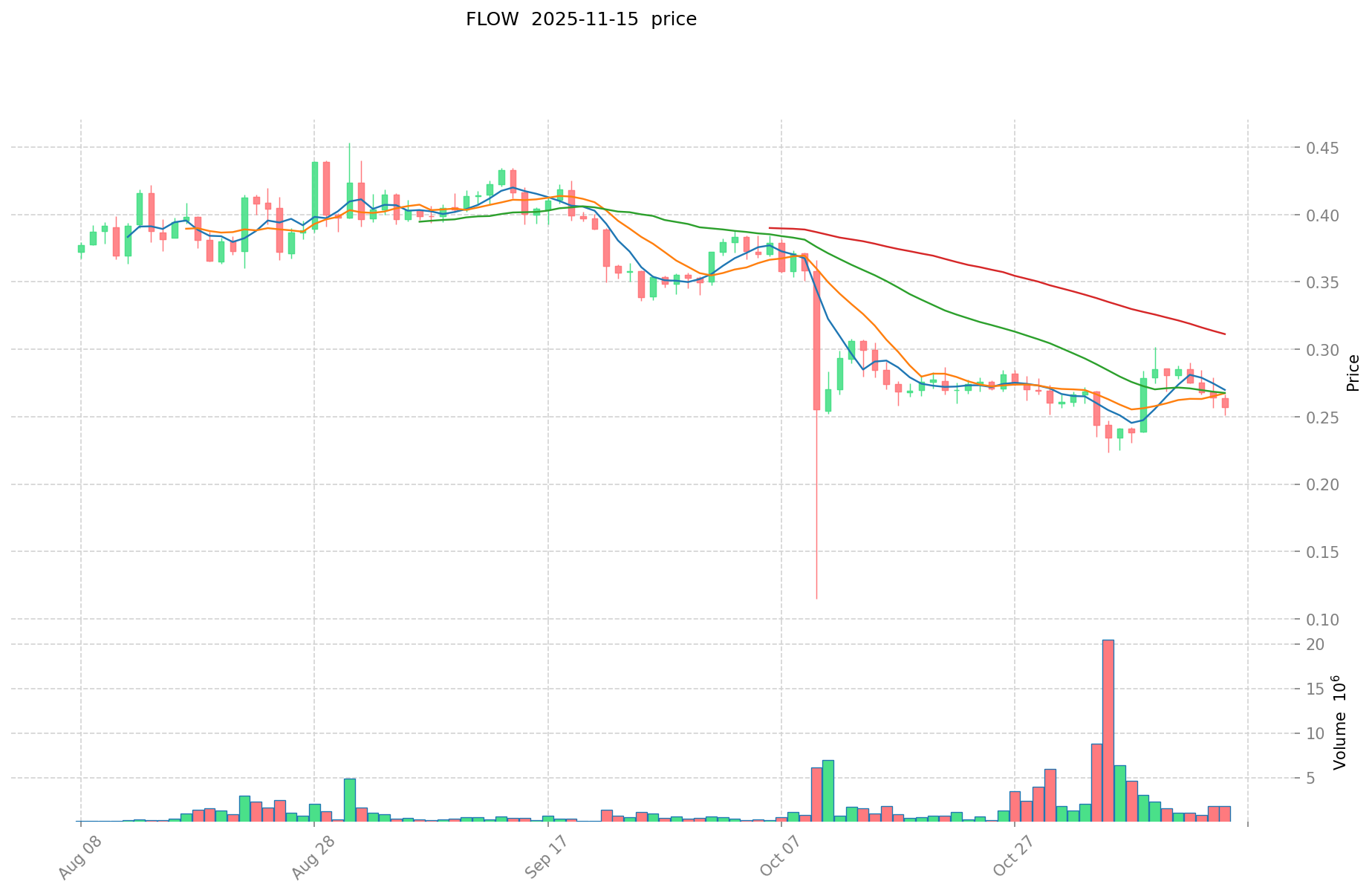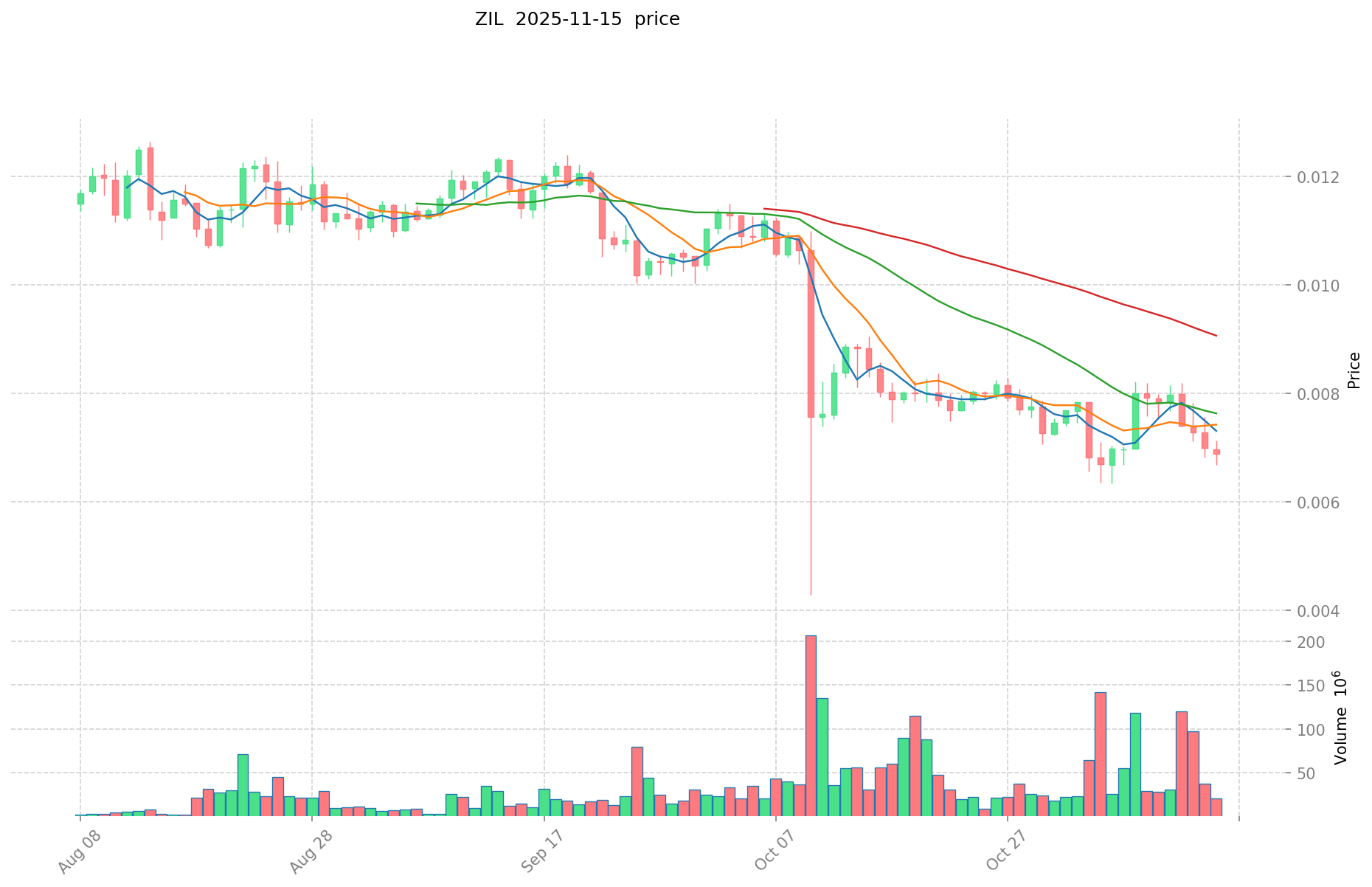FLOW vs ZIL: A Comparative Analysis of Two Leading Blockchain Platforms for dApp Development
Introduction: Investment Comparison between FLOW and ZIL
In the cryptocurrency market, the comparison between FLOW vs ZIL has always been a topic that investors cannot ignore. The two not only have significant differences in market capitalization ranking, application scenarios, and price performance, but also represent different cryptocurrency asset positioning.
FLOW (FLOW): Since its launch in 2020, it has gained market recognition for its platform for next-generation games, applications, and digital assets.
ZIL (ZIL): Since its introduction in 2018, it has been hailed as a high-throughput public blockchain platform, aiming to solve transaction speed and scalability issues.
This article will comprehensively analyze the investment value comparison between FLOW vs ZIL, focusing on historical price trends, supply mechanisms, institutional adoption, technological ecosystems, and future predictions, and attempt to answer the question that investors are most concerned about:
"Which is the better buy right now?"
I. Price History Comparison and Current Market Status
FLOW (Coin A) and ZIL (Coin B) Historical Price Trends
- 2021: FLOW reached its all-time high of $42.4 on April 5, 2021, likely due to increased adoption and interest in the Flow blockchain.
- 2020: ZIL hit its all-time low of $0.00239616 on March 13, 2020, possibly affected by the global market crash during the early stages of the COVID-19 pandemic.
- Comparative analysis: Since their respective peaks, both coins have experienced significant declines. FLOW has fallen from its all-time high of $42.4 to its current price of $0.2649, while ZIL has dropped from its all-time high of $0.255376 to $0.007139.
Current Market Situation (2025-11-15)
- FLOW current price: $0.2649
- ZIL current price: $0.007139
- 24-hour trading volume: FLOW $165,224.48 vs ZIL $145,016.51
- Market Sentiment Index (Fear & Greed Index): 10 (Extreme Fear)
Click to view real-time prices:
- View FLOW current price Market Price
- View ZIL current price Market Price


II. Core Factors Affecting Investment Value of FLOW vs ZIL
Supply Mechanism Comparison (Tokenomics)
- FLOW: Fixed maximum supply of 1,378,211,739 FLOW with inflation rate decreasing over time
- ZIL: Maximum supply of 21 billion ZIL with deflationary mechanism through fee burning
- 📌 Historical pattern: Limited supply cryptocurrencies tend to appreciate more during bull markets, with deflationary mechanisms potentially providing price support during market consolidation.
Institutional Adoption and Market Applications
- Institutional holdings: FLOW has attracted more institutional interest through partnerships with major brands like NBA, NFL, and UFC
- Enterprise adoption: FLOW has more established corporate applications in NFT marketplaces and digital collectibles, while ZIL focuses more on DeFi and payment solutions
- National policies: Both face similar regulatory scrutiny in most jurisdictions, though neither has significant regulatory advantages
Technical Development and Ecosystem Building
- FLOW technical upgrades: Multi-node architecture, resource-oriented programming, and consumer-friendly wallet experiences
- ZIL technical development: Practical Byzantine Fault Tolerance (pBFT) consensus, sharding technology for scalability
- Ecosystem comparison: FLOW has stronger NFT marketplace development and gaming applications, while ZIL has more focus on DeFi protocols and payment solutions
Macroeconomic Factors and Market Cycles
- Performance in inflationary environments: Both assets have struggled during high inflation periods
- Macroeconomic monetary policy: Both cryptocurrencies show high correlation to risk assets and are negatively impacted by rising interest rates
- Geopolitical factors: Neither cryptocurrency has demonstrated significant advantage in cross-border transaction demand related to geopolitical developments
III. 2025-2030 Price Prediction: FLOW vs ZIL
Short-term Prediction (2025)
- FLOW: Conservative $0.15635 - $0.265 | Optimistic $0.265 - $0.3286
- ZIL: Conservative $0.00449757 - $0.007139 | Optimistic $0.007139 - $0.00892375
Mid-term Prediction (2027)
- FLOW may enter a growth phase, with expected prices ranging from $0.18532192 to $0.45337684
- ZIL may enter a growth phase, with expected prices ranging from $0.0052942824 to $0.0110021806125
- Key drivers: Institutional capital inflow, ETF, ecosystem development
Long-term Prediction (2030)
- FLOW: Base scenario $0.467173560546 - $0.5839669506825 | Optimistic scenario $0.5839669506825+
- ZIL: Base scenario $0.012907166823973 - $0.013423453496932 | Optimistic scenario $0.013423453496932+
Disclaimer: This analysis is based on historical data and projections. Cryptocurrency markets are highly volatile and unpredictable. Always conduct your own research before making investment decisions.
FLOW:
| 年份 | 预测最高价 | 预测平均价格 | 预测最低价 | 涨跌幅 |
|---|---|---|---|---|
| 2025 | 0.3286 | 0.265 | 0.15635 | 0 |
| 2026 | 0.365064 | 0.2968 | 0.151368 | 12 |
| 2027 | 0.45337684 | 0.330932 | 0.18532192 | 24 |
| 2028 | 0.4274483178 | 0.39215442 | 0.2588219172 | 48 |
| 2029 | 0.524545752192 | 0.4098013689 | 0.274566917163 | 54 |
| 2030 | 0.5839669506825 | 0.467173560546 | 0.28964760753852 | 76 |
ZIL:
| 年份 | 预测最高价 | 预测平均价格 | 预测最低价 | 涨跌幅 |
|---|---|---|---|---|
| 2025 | 0.00892375 | 0.007139 | 0.00449757 | 0 |
| 2026 | 0.0085132575 | 0.008031375 | 0.00457788375 | 12 |
| 2027 | 0.0110021806125 | 0.00827231625 | 0.0052942824 | 15 |
| 2028 | 0.0131066578665 | 0.00963724843125 | 0.005204114152875 | 34 |
| 2029 | 0.014442380499071 | 0.011371953148875 | 0.006936891420813 | 59 |
| 2030 | 0.013423453496932 | 0.012907166823973 | 0.010971091800377 | 80 |
IV. Investment Strategy Comparison: FLOW vs ZIL
Long-term vs Short-term Investment Strategies
- FLOW: Suitable for investors focused on NFT marketplaces and gaming ecosystems
- ZIL: Suitable for investors interested in DeFi protocols and payment solutions
Risk Management and Asset Allocation
- Conservative investors: FLOW 40% vs ZIL 60%
- Aggressive investors: FLOW 60% vs ZIL 40%
- Hedging tools: Stablecoin allocation, options, cross-currency portfolios
V. Potential Risk Comparison
Market Risk
- FLOW: Highly dependent on NFT market trends and gaming industry adoption
- ZIL: Vulnerable to competition in the crowded DeFi and payment solution space
Technical Risk
- FLOW: Scalability, network stability
- ZIL: Hash power concentration, security vulnerabilities
Regulatory Risk
- Global regulatory policies may impact both differently, with NFT-focused FLOW potentially facing more scrutiny in some jurisdictions
VI. Conclusion: Which Is the Better Buy?
📌 Investment Value Summary:
- FLOW advantages: Strong institutional partnerships, established NFT ecosystem
- ZIL advantages: Focus on scalability, DeFi applications, and payment solutions
✅ Investment Advice:
- New investors: Consider a balanced approach with a slight bias towards FLOW due to its stronger brand partnerships
- Experienced investors: Evaluate based on personal risk tolerance and belief in NFT vs DeFi growth
- Institutional investors: Consider FLOW for NFT exposure and ZIL for DeFi diversification
⚠️ Risk Warning: Cryptocurrency markets are highly volatile. This article does not constitute investment advice. None
VII. FAQ
Q1: What are the main differences between FLOW and ZIL? A: FLOW focuses on NFT marketplaces and gaming ecosystems, while ZIL concentrates on DeFi protocols and payment solutions. FLOW has stronger institutional partnerships, while ZIL emphasizes scalability through sharding technology.
Q2: Which coin has performed better historically? A: Both coins have experienced significant declines from their all-time highs. FLOW reached its peak of $42.4 in April 2021, while ZIL's all-time high was $0.255376. As of 2025-11-15, FLOW is trading at $0.2649, and ZIL at $0.007139.
Q3: How do their supply mechanisms differ? A: FLOW has a fixed maximum supply of 1,378,211,739 tokens with a decreasing inflation rate. ZIL has a maximum supply of 21 billion tokens and implements a deflationary mechanism through fee burning.
Q4: Which coin is better for short-term investment? A: Short-term investment depends on market conditions and risk tolerance. For 2025, FLOW's optimistic prediction ranges from $0.265 to $0.3286, while ZIL's ranges from $0.007139 to $0.00892375.
Q5: How do institutional adoptions compare between FLOW and ZIL? A: FLOW has attracted more institutional interest through partnerships with major brands like NBA, NFL, and UFC. ZIL has fewer high-profile institutional partnerships but focuses more on DeFi and payment solutions adoption.
Q6: What are the main risks associated with investing in FLOW and ZIL? A: Both face market risks, technical risks, and regulatory risks. FLOW is highly dependent on NFT market trends, while ZIL is vulnerable to competition in the DeFi space. Both may be impacted by global regulatory policies, with FLOW potentially facing more scrutiny due to its NFT focus.
Q7: How should investors allocate their assets between FLOW and ZIL? A: Conservative investors might consider allocating 40% to FLOW and 60% to ZIL, while aggressive investors might opt for 60% FLOW and 40% ZIL. However, individual allocations should be based on personal risk tolerance and market analysis.
Share
Content